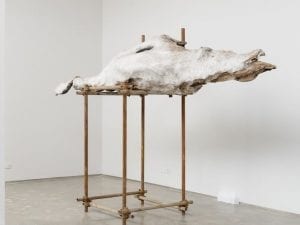New York-based artist Tara Donovan comes to Scotland for the first time, with an exhibition of sculptural works at Jupiter Artland, as part of the annual Edinburgh Art Festival (EAF). Bringing together two key pieces, Untitled (Mylar) and Untitled (Plastic Cups), the presentation in Edinburgh celebrates the artist’s use of recognisable everyday materials to create large scale sculptures that resemble elements from nature viewed under a microscope, or organisms from the depths of the ocean. Donovan’s Untitled (Plastic Cups) at Bonnington House’s Ballroom marks the inauguration of the space with an expansive installation consisting of over 500,000 drinking cups. We speak to the artist about her participation in this year’s EAF and discover more about her developing creative practice, which draws inspiration from both the man-made and natural worlds.
A: This is your first time at the Edinburgh Art Festival. What does it mean for you to be exhibiting at this international presentation, and in your opinion, how does the festival celebrate contemporary artistic talent?
TD: The Jupiter Artland exhibition is my first presentation in Scotland. I have been extremely impressed with the scale and profile of the festival, which has brought together a diverse sampling of innovative artists engaged in ambitious practices defining the field of contemporary art.
A: Your work transforms everyday objects into mesmerising organic forms. Where do you look for inspiration, and is there an active intention to combine modern consumer materials with the natural world and elements of science?
TD: While I am always looking at materials for possibilities, I often find inspiration is more of a spontaneous phenomenon rather than a strategic result. The forms I develop result from a type of dialogue with the material itself. In a sense, it is the material itself that dictates the forms that develop.
A: For the festival, you have installed three works at Jupiter Artland, including in Bonnington House’s Ballroom. Can you talk a little about the pieces, and how they have been adapted to fit the space?
TD: I tend to think of scale in work in a way akin to modernist painting in that an infinite field of activity is only delimited by the frame. However, in my case, the frame is the actual architectural particulars of the space as a container. I adapt the volume of material and scale of each project for a given space.
A: Based in New York, you are represented by Pace Gallery. What have been your highlights from the last five years?
TD: My exhibitions at Pace over the last five years represent the culmination of long-term, studio-based production processes that only come together in monumental presentations at the gallery. The pin drawings as well as the acrylic rod, index card and mylar installations all debuted at Pace within the last five years. In addition, my major museum solo exhibitions include the Arp Museum Bahnhof Rolandseck in Remagen, Germany, and the Louisiana Museum of Modern Art in Humlebæk, Denmark (2013-2014), the Milwaukee Art Museum (2012), and the Indianapolis Museum of Art (2010).
A: Your participation in EAF marks your large-scale debut in the UK. Where do you see your career developing as you discover new environments and forms to influence your work?
TD: Edinburgh has been an incredibly positive experience. I plan to continue to focus on developing audiences in diverse international contexts. It is always a pleasure to discover the more idiosyncratic ways my work is received in different places around the globe.
Tara Donovan, until 27 September, Jupiter Artland, Bonnington House Steadings, Wilkieston, Edinburgh, EH27 8BB.
Visit the festival website: www.edinburghartfestival.com. See more at www.jupiterartland.org.
Find out about Tara Donovan here.
Follow us on Twitter @AestheticaMag for the latest news in contemporary art and culture.
Credits
1. Tara Donovan, Untitled (Plastic Cups), 2006, site specific, dimensions variable. Photo Keith Hunter. Courtesy of the artist and Jupiter Artland.





